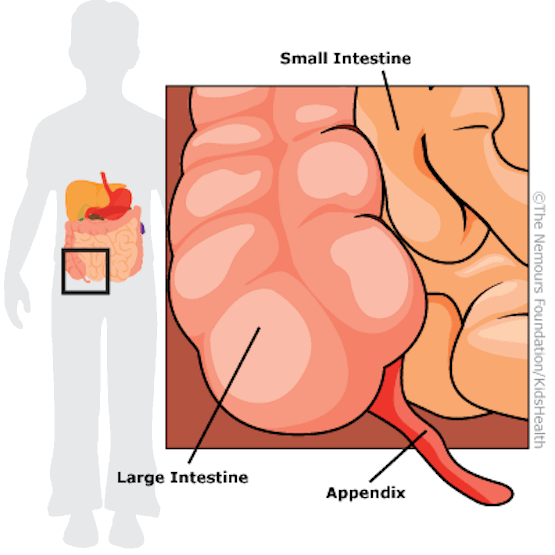
What is appendicitis?
You will find information here about appendicitis
Appendicitis is an acute inflammation of appendix - a condition where the appendix becomes swollen, inflamed, and filled with pus. The appendix is a small finger-shaped pouch on the right side of the abdomen and it is connected to the colon (large intestine). Appendicitis probably happens because either a stomach infection moves to the appendix or a hard piece of stool becomes trapped in the appendix, causing infection. Appendicitis is the most common non-traumatic surgical emergency in children.1,2 Each year, an estimated 33,000 Canadians develop appendicitis and 7,100 of them are children.3 For every child who is ultimately diagnosed with appendicitis, pediatric Emergency Departments (EDs) across Canada carry out extensive investigations in 4–5 children, resulting in significant expenditure of health system resources and time. Suspicion of appendicitis is a common reason for transfer to tertiary care facilities from community settings.4 Appendicitis is one of the most common causes of hospital admission in children with an average hospital length of stay of 3.2 days.5

Identifying appendicitis in children can be challenging for health care providers. Children with appendicitis present to the ED with undifferentiated complaints and atypical features.6 The most common features of appendicitis include:
- strong abdominal pain, mainly around the belly button or in the lower right part of the belly
- fever
- nausea and/or vomiting
- loss of appetite
- diarrhea
This lack of “classic” features makes it challenging to differentiate those with appendicitis from those with benign, self-limited illness. In a recent study, only 69% of those felt to be at high risk of appendicitis (90%–100% probability based on clinical gestalt) truly had appendicitis.7 Clinicians currently identify appendicitis using clinical history, physical exam, basic laboratory tests (for example: White Blood Cells (WBC) count, Neutrophil Count (NC), C-Reactive Protein (CRP) level), and imaging studies (Ultrasound (US) and Computed Tomography (CT)). Each has its own limitations in accuracy, availability and/or adverse effects.1,8–14 Attempts to maximize test performance characteristics through various combinations of clinical findings and laboratory results have led to development of clinical scores such as the Pediatric Appendicitis Score (PAS)15–18 and the Alvarado Score (AS).18–21 Further combinations of clinical scores and investigations (laboratory and imaging) have demonstrated improvement in sensitivity, but poor specificity precludes their routine use in clinical practice.22–25 The optimal diagnostic strategy remains unknown; we recently demonstrated significant variations in the use of diagnostic investigations across Canadian pediatric EDs.5
Delays in identifying appendicitis can have serious adverse outcomes, including perforation of the appendix, abscess formation, sepsis and death.26–32 Missed diagnoses and misdiagnoses remain a problem. Children under 5 years are at particularly high risk of delayed identification33 and higher perforation rates that are correlated to age.34 For example children under 12 months of age have perforation rates approaching 85%35 (compared to 17% in Canadian children across all ages).5 False positive diagnoses can also lead to negative patient outcomes. Appendicitis may be mimicked by other causes of right lower quadrant pain (e.g. gastroenteritis, constipation, inguinal hernia, intussuception, ovarian torsion, renal colic).36,37 Misdiagnosing any of these conditions as appendicitis places the patient at risk of surgical and/or anesthetic complications38–40 from unnecessary procedures, and of delayed management for the true underlying condition. Negative appendectomy rates in Canadian pediatric EDs range from 2% to 22% (mean of 6.8%).5 Appendicitis is a significant concern for parents of children with abdominal pain and is an illness associated with high litigious risk.31,41,42 Delay in identifying appendicitis is the most common issue in medico-legal cases involving pediatric appendicitis in Canada43 and the United States.44
Precision medicine ("bioprofiling") is the next generation of diagnostics in appendicitis. The current laboratory diagnostic paradigm in pediatric appendicitis relies on individual biomarkers, most often related to infection (WBC, NC) and inflammation (CRP) which have significant limitations. Newer testing modalities have analyzed further biomarkers for appendicitis in children: calprotectin and leucine-rich alpha glycoprotein-1 have been shown to have high sensitivity but very low specificity (23%–35%)45 while urinary 5-hydroxyindoleacetic acid has demonstrated reasonable specificity but very low sensitivity (44%).46 More recently, a multi-variable bio-profile named APPY1 (WBC, CRP + calprotectin) demonstrated excellent sensitivity and negative predictive values; unfortunately specificity remains low (33%–43%).47-49 To date, common approaches to diagnostic biomarkers have been limited by a) relying on finding “the one” single marker, b) failure to integrate clinical data or c) relying on a single precision medicine platform. In contrast, our Appendicitis Research team members are conducting novel studies which demonstrate that integrative "bioprofiling" approach improves diagnosis of severe infections in children.50,51 The goal of the Appendicitis Research team is to improve the diagnosis and management of pediatric appendicitis by applying this innovative precision medicine approach. To learn more about our current appendicitis research projects please check our research section.
1. Bundy, Byerley, Liles, Perrin, Katznelson, Rice. Does This Child Have Appendicitis? JAMA. 2007 298(4):438-451.
2. Rentea, SDS P. Pediatric Appendicitis. The Surgical Clinics of North America. 2017 97(1):93-112.
3. Ferris, Quan, Kaplan, et al. The Global Incidence of Appendicitis: A Systematic Review of Population-based Studies. Annals of Surgery. 2017 266(2):237.
4. Loke, Tantoco, Ferguson, et al. Accuracy of inter-hospital paediatric appendicitis referrals. Emergency Medicine Australasia. 2012 24(4):414-9.
5. Thompson, Schuh, Gravel, et al. Variation in the Diagnosis and Management of Appendicitis at Canadian Pediatric Hospitals. Academic Emergency Medicine. 2015 22(7):811-22.
6. Becker, Kharbanda, Bachur. Atypical Clinical Features of Pediatric Appendicitis. Academic Emergency Medicine. 2007 14(2):124-129.
7. Kene M, Ballard D, Liu M, et al. Performance of clinical gestalt in predicting pediatric appendicitis: Does experience Matter? American College of Emergency Physicians Research Forum. 2018 Vol 70:S98.
8. Brenner, Elliston, Hall, Berdon. Estimated Risks of Radiation-Induced Fatal Cancer from Pediatric CT. American Journal of Roentgenology. 2001 176(2):289-296.
9. Brenner, Hall. Computed Tomography — An Increasing Source of Radiation Exposure. The New England Journal of Medicine. 2007 357(22):2277-2284.
10. Ross, Liu, Netherton, et al. Outcomes of children with suspected appendicitis and incompletely visualized appendix on ultrasound. Academic Emergency Medicine. 2014 21(5):538-42.
11. Khanafer, Martin, Mitra, et al. Test characteristics of common appendicitis scores with and without laboratory investigations: a prospective observational study. BMC pediatrics. 2016 16(1):147.
12. Thompson G. Clinical Scoring Systems in the Management of Suspected Appendicitis in Children. In: Appendicitis – A Collection of Essays from Around the World. http://www.intechopen.com/articles/show/title/clinical-scoring-systems-in-themanagement-of-suspected-appendicitis-in-children. InTech Open; 2012.
13. Thompson, Morrison, Ross, Liu, Vanderkooi, Eccles. The Use of Routine Blood Cultures in Pediatric Appendicitis. Pediatric Emergency Care. 2017 33(12):e160.
14. Benabbas, Hanna, Shah, Sinert. Diagnostic Accuracy of History, Physical Examination, Laboratory Tests, and Point-of-care Ultrasound for Pediatric Acute Appendicitis in the Emergency Department: A Systematic Review and Meta-analysis. Academic emergency medicine. 2017 24(5):523-551.
15. Samuel. Pediatric appendicitis score. Journal of Pediatric Surgery. 2002 37(6):877-881.
16. Goldman, Carter, Stephens, Antoon, Mounstephen, Langer. Prospective Validation of the Pediatric Appendicitis Score. The Journal of Pediatrics. 2008 153(2):278-282.
17. Bhatt, Joseph, Ducharme, Dougherty, McGillivray. Prospective Validation of the Pediatric Appendicitis Score in a Canadian Pediatric Emergency Department. Academic Emergency Medicine. 2009 16(7):591-596.
18. Kulik, Uleryk, Maguire. Does this child have appendicitis? A systematic review of clinical prediction rules for children with acute abdominal pain. Journal of Clinical Epidemiology. 2013 66(1):95-104.
19. Alvarado. A Practical Score for the Early Diagnosis of Acute Appendicitis. Pediatric Emergency Care. 1986 2(3):206.
20. Schneider, Kharbanda, Bachur. Evaluating Appendicitis Scoring Systems Using a Prospective Pediatric Cohort. Annals of Emergency Medicine. 2007 49(6):778-784.e1.
21. Mandeville, Pottker, Bulloch, Liu. Using appendicitis scores in the pediatric ED. The American Journal of Emergency Medicine. 2011 29(9):972-977.
22. Blitman, Anwar, Brady, Taragin, Freeman. Value of Focused Appendicitis Ultrasound and Alvarado Score in Predicting Appendicitis in Children: Can We Reduce the Use of CT? American Journal of Roentgenology. 2015 204(6):W707-12.
23. Jones, Jeffrey, Shah, Desser, Rosenberg, Olcott. Journal Club: the Alvarado score as a method for reducing the number of CT studies when appendiceal ultrasound fails to visualize the appendix in adults. American Journal of Roentgenology. 2015 204(3):519-26.
24. Athans, Depinet, Towbin, Zhang, Zhang, Trout. Use of Clinical Data to Predict Appendicitis in Patients with Equivocal US Findings. Radiology. 2016 280(2):557-67.
25. Bachur, Callahan, Monuteaux, Rangel. Integration of ultrasound findings and a clinical score in the diagnostic evaluation of pediatric appendicitis. The Journal of Pediatrics. 2015 166(5):1134-9.
26. Pledger, Fahy, GAV M, Bush. Deaths in children with a diagnosis of acute appendicitis in England and Wales 1980-4. Br Med J (Clin Res Ed). 1987 295(6608):1233-1235.
27. Pledger, Stringer. Childhood deaths from acute appendicitis in England and Wales 1963-97: observational population based study. BMJ. 2001 323(7310):430-431.
28. Neuspiel, Kuller. Fatalities From Undetected Appendicitis in Early Childhood. Clinical Pediatrics. 1987 26(11):573-575.
29. Andersson, Andersson. Causes of Short-Term Mortality After Appendectomy: A Population-Based Case-Controlled Study. Annals of Surgery. 2011 254(1):103.
30. Blomqvist, REB A, Granath, Lambe, Ekbom. Mortality After Appendectomy in Sweden, 1987–1996. Annals of Surgery. 2001 233(4):455.
31. Selbst, Friedman, Singh. Epidemiology and etiology of malpractice lawsuits involving children in US emergency departments and urgent care centers. Pediatric Emergency Care. 2005 21(3):165-9.
32. Papandria, Goldstein, Rhee, et al. Risk of perforation increases with delay in recognition and surgery for acute appendicitis. Journal of Surgical Research. 2013 184(2):723-729.
33. Williams, Kapila. Acute appendicitis in the under-5 year old. Journal of the Royal College of Surgeons of Edinburgh. 1994 39(3):168-70.
34. Lee, Stark, Yaghoubian, Shekherdimian, Kaji. Does age affect the outcomes and management of pediatric appendicitis? Journal of Pediatric Surgery. 2011 46(12):2342-2345.
35. Bansal, Banever, Karrer, Partrick. Appendicitis in children less than 5 years old: influence of age on presentation and outcome. The American Journal of Surgery. 2012 204(6):1031-1035.
36. Seah, Ng. Pitfalls in Paediatric Appendicitis: Highlighting Common Clinical Features of Missed Cases. Asian Journal of Surgery. 2006 29(4):262-266.
37. Naiditch, Lautz, Daley, Pierce, Reynolds. The Implications of Missed Opportunities to Diagnose Appendicitis in Children. Academic Emergency Medicine. 2013 20(6):592-596.
38. Tay, Tan, Ng. Critical incidents in paediatric anaesthesia: an audit of 10 000 anaesthetics in Singapore. Paediatric Anaesthesia. 2001 11(6):711-8.
39. Andropoulos, Greene. Anesthesia and Developing Brains - Implications of the FDA Warning. The New England Journal of Medicine. 2017 376(10):905-907.
40. BSV U-S, Ramgolam, Hall, Sly, Habre. Peri-operative adverse respiratory events in children. Anaesthesia. 2015 70(4):440-4.
41. Raine. An analysis of successful litigation claims in children in England. Archives of Disease in Childhood. 2011 96(9):838-840.
42. Brown, McCarthy, Kelen, Levy. An Epidemiologic Study of Closed Emergency Department Malpractice Claims in a National Database of Physician Malpractice Insurers. Academic Emergency Medicine. 2010 17(5):553-560.
43. Canadian Medical Protective Association. Appendicitis — Lessons learned. https://www.cmpa-acpm.ca/en/advice-publications/browse-articles/2013/appendicitislessons-learned. Accessed February 28, 2018.
44. Sullins, Rouch, Lee. Malpractice in Cases of Pediatric Appendicitis. Clinical Pediatrics. 2017 56(3):226-230.
45. Kharbanda, Rai, Cosme, Liu, Dayan. Novel serum and urine markers for pediatric appendicitis. Academic Emergency Medicine. 2012 19(1):56-62.
46. Jangjoo, Varasteh, Bahar, et al. Is urinary 5-hydroxyindoleacetic acid helpful for early diagnosis of acute appendicitis? The American Journal of Emergency Medicine. 2012 30(4):540-544.
47. Huckins, Simon, Copeland, Spiro, Gogain, Wandell. A novel biomarker panel to rule out acute appendicitis in pediatric patients with abdominal pain. The American Journal of Emergency Medicine. 2013 31(9):1368-75.
48. Depinet, Copeland, Gogain, et al. Addition of a biomarker panel to a clinical score to identify patients at low risk for appendicitis. The American Journal of Emergency Medicine. 2016 34(12):2266-2271.
49. Huckins, Copeland, Self, et al. Diagnostic performance of a biomarker panel as a negative predictor for acute appendicitis in adult ED patients with abdominal pain. The American Journal of Emergency Medicine. 2017 35(3):418-424.
50. Mickiewicz, Thompson, Blackwood, et al. Development of metabolic and inflammatory mediator biomarker phenotyping for early diagnosis and triage of pediatric sepsis. Critical care. 2015 19:320.
51. Mickiewicz, Tam, Jenne, et al. Integration of metabolic and inflammatory mediator profiles as a potential prognostic approach for septic shock in the intensive care unit. Critical Care. 2014 19(1):1-12.
